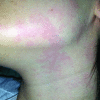Postural orthostatic tachycardia syndrome: a dermatologic perspective and successful treatment with losartan
- PMID: 25161760
- PMCID: PMC4142820
Postural orthostatic tachycardia syndrome: a dermatologic perspective and successful treatment with losartan
Abstract
The postural orthostatic tachycardia syndrome is a disease characterized by excessively increased heart rate during orthostatic challenge associated with symptoms of orthostatic intolerance including dizziness, exercise intolerance, headache, fatigue, memory problems, nausea, blurred vision, pallor, and sweating, which improve with recumbence. Postural orthostatic tachycardia syndrome patients may present with a multitude of additional symptoms that are attributable to vascular vasoconstriction. Observed signs and symptoms in a patient with postural orthostatic tachycardia syndrome include tachycardia at rest, exaggerated heart rate increase with upright position and exercise, crushing chest pain, tremor, syncope, loss of vision, confusion, migraines, fatigue, heat intolerance, parasthesia, dysesthesia, allodynia, altered traditional senses, and thermoregulatory abnormalities. There are a number of possible dermatological manifestations of postural orthostatic tachycardia syndrome easily explained by its recently discovered pathophysiology. The author reports the case of a 22-year-old woman with moderate-to-severe postural orthostatic tachycardia syndrome with numerous dermatological manifestations attributable to the disease process. The cutaneous manifestations observed in this patient are diverse and most noticeable during postural orthostatic tachycardia syndrome flares. The most distinct are evanescent, hyperemic, sharply demarcated, irregular patches on the chest and neck area that resolve upon diascopy. This distinct "evanescent hyperemia" disappears spontaneously after seconds to minutes and reappears unexpectedly. Other observed dermatological manifestations of this systemic disease include Raynaud's phenomenon, koilonychia, onychodystrophy, madarosis, dysesthesia, allodynia, telogen effluvium, increased capillary refill time, and livedo reticularis. The treatment of this disease poses a great challenge. The author reports the unprecedented use of an oral angiotensin II type 1 receptor antagonist resulting in remarkable improvement.
Figures
Similar articles
-
Dermatological Manifestations of Postural Tachycardia Syndrome Are Common and Diverse.J Clin Neurol. 2016 Jan;12(1):75-8. doi: 10.3988/jcn.2016.12.1.75. Epub 2015 Nov 26. J Clin Neurol. 2016. PMID: 26610893 Free PMC article.
-
The Dermatological Manifestations of Postural Tachycardia Syndrome: A Review with Illustrated Cases.Am J Clin Dermatol. 2015 Oct;16(5):425-30. doi: 10.1007/s40257-015-0144-6. Am J Clin Dermatol. 2015. PMID: 26242228 Review.
-
[Clinical analysis and follow-up study of postural orthostatic tachycardia syndrome in 28 pediatric cases].Zhonghua Er Ke Za Zhi. 2005 Mar;43(3):165-9. Zhonghua Er Ke Za Zhi. 2005. PMID: 15833184 Chinese.
-
Prevalence of joint hypermobility, postural orthostatic tachycardia syndrome (POTS), and orthostatic hypotension in school-children.Andes Pediatr. 2022 Feb;93(1):53-58. doi: 10.32641/andespediatr.v93i1.3755. Epub 2022 Mar 29. Andes Pediatr. 2022. PMID: 35506776 English, Spanish.
-
Orthostatic intolerance and the headache patient.Semin Pediatr Neurol. 2010 Jun;17(2):109-16. doi: 10.1016/j.spen.2010.04.006. Semin Pediatr Neurol. 2010. PMID: 20541103 Review.
Cited by
-
Cutaneous manifestations of orthostatic intolerance syndromes.Int J Womens Dermatol. 2021 Mar 11;7(4):471-477. doi: 10.1016/j.ijwd.2021.03.003. eCollection 2021 Sep. Int J Womens Dermatol. 2021. PMID: 34621961 Free PMC article.
-
Dermatological Manifestations of Postural Tachycardia Syndrome Are Common and Diverse.J Clin Neurol. 2016 Jan;12(1):75-8. doi: 10.3988/jcn.2016.12.1.75. Epub 2015 Nov 26. J Clin Neurol. 2016. PMID: 26610893 Free PMC article.
-
A survey-based analysis of symptoms in patients with postural orthostatic tachycardia syndrome.Proc (Bayl Univ Med Cent). 2015 Apr;28(2):157-9. doi: 10.1080/08998280.2015.11929217. Proc (Bayl Univ Med Cent). 2015. PMID: 25829642 Free PMC article.
References
-
- Scondorf F, Low PA. Idiopathic postural orthostatic tachycardia syndrome. An attenuated form of acute pandysautonomia? Neurology. 1993;43(1):132–137. - PubMed
-
- Grubb B. Postural tachycardia syndrome. Circulation. 2008;117:2814–2817. - PubMed
-
- Satish RR, Bioaggioni I, Yamhure PC, et al. Renin-aldosterone paradox and perturbed blood volume regulation underlying postural tachycardia syndrome. Circulation. 2005;111:1574–1582. - PubMed
LinkOut - more resources
Full Text Sources


